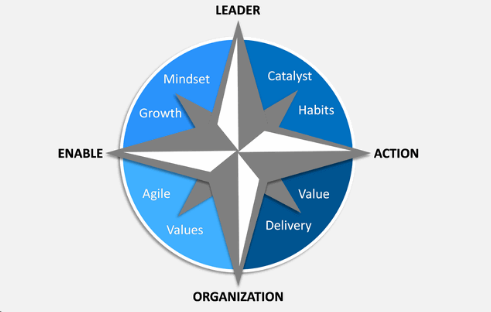In the workplace, managers employ a variety of leadership philosophies. While some philosophies may foster an environment where employees are autonomous, others may promote collaboration and foster a more structured setting. In order to lessen workplace conflict and promote more fruitful working relationships among employees, facilitative leadership is a style or method of leading others that involves managing divergent viewpoints. If you hold a leadership position, learning more about this leadership style may make it easier for you to manage staff and promote inclusion at work.
In this article, we define facilitative leadership, outline the key characteristics of a facilitative leader, provide some advice for putting this leadership style into practice, and go over some of the advantages of doing so.
Table of Contents
What is Facilitative Leadership?
The goal of facilitative leadership is to align the contributions and ideas of all team members in order to enable teams to more easily accomplish shared objectives. This leadership approach seeks to put more inclusive processes in place to support each employee’s contribution and may reduce potential conflicts that may arise from divergent opinions or ideas. Leadership that fosters collaboration can make workers feel more at ease sharing their knowledge and suggestions.
Facilitative leadership seeks to include every team member in each step of the decision-making process, in contrast to other styles of leadership. Before making a decision that will have an impact on the entire group, the facilitative leader typically consults with the staff they are responsible for. In decentralized organizations, where managers frequently solicit feedback from staff members before making decisions, this leadership style is frequently advantageous.
Traits of Facilitative Leaders

Numerous characteristics of facilitative leaders make their workplaces more collaborative and effective. Some of these traits include:
- Attentiveness: Good facilitators pay close attention to their team members’ input and use it to guide their decisions. In an effort to ensure that there is a high level of attention to detail at work, they are frequently willing to meet with each employee separately to discuss their concerns.
- Communication: Clearly communicating information to staff members, both orally and in writing, is another skill that facilitative leaders possess. They employ their communication abilities to moderate conversations and are prepared to change their communication approach depending on the circumstance.
- Creativity: A leader who is good at fostering innovation in others can often inspire their team members to be creative themselves. Even in ambiguous situations, they are able to create original solutions to complex problems and give employees clarity.
- Emotional intelligence: These leaders are able to maintain their composure in stressful circumstances because they are aware of their own emotions and reactions. To avoid conflict and ensure that teams remain productive, they can also recognize and affect other people’s emotions.
- Transparency: Sincere communication with team members and transparency in setting goals for oneself and others are qualities of effective facilitators. This enables them to effectively direct and manage people and resources, thereby raising employee engagement and performance.
- Fairness: Facilitative leaders frequently make an effort to hear the ideas and suggestions of all team members, and they may put procedures in place to make sure that they manage employees fairly. They are able to foster a happier workplace and lessen resentment as a result.
- Decisiveness: While the facilitative leadership style frequently enables workers and their managers to make decisions together, there are some circumstances that necessitate facilitative leaders making decisions on behalf of their teams. They can better handle situations and reach decisions that benefit both parties if they are decisive.
- Encouragement: When employees need assistance, facilitative leaders are frequently eager to help by offering them useful resources and tools. They also frequently make an effort to reassure workers, and they might even give them useful criticism to help them get better at their jobs.
- Observation: Good facilitators are usually keen observers who base their decisions on the data they gather. Their capacity for observation enables them to make accurate assessments of situations and aids in the discovery of employees’ strengths.
- Organization: The ability to prioritize their time and make sure that everyone on their team is working to their full potential with the aid of the organization can help facilitative leaders. Each day, effective facilitators plan their schedules to make it easier to manage their tasks and meetings.
Tips for Practicing Facilitative Leadership
If you want to become a more facilitative leader in the workplace, here are a few tips for you to consider:
Encourage Active Participation
In order to foster creative thinking among your team members as they work on a project or task, you must encourage new ideas. In the workplace, make an effort to promote active participation and communicate your appreciation for employee input. For instance, if you oversee a group of salespeople and you want to develop a new method of tracking leads, ask your team for input before implementing the new method rather than coming up with the idea yourself.
Giving staff members a voice in planning and decision-making can help you better ensure that the project or procedure meets their needs. It can also assist you in raising your chances of long-term success. Team members may be more inclined to stick with the organization and strive to keep up their high level of performance if they believe that company leaders value their opinions.
Inspire Your Team
Empowering staff members to complete tasks in a way that promotes long-term productivity and adds value to the organization is a requirement of facilitative leadership. Encourage team unity and reward top performers by making each team member feel valued. Explain the purpose of a new policy or procedure to your staff before putting it into effect, and solicit their feedback. Your employees can then be informed of your long-term objectives and inspired to create their own.
Keep in mind your own values as well and incorporate them into your work. As an illustration, if you value communication, create an open line of communication so team members can voice their concerns and offer you feedback. If you value honesty, then admitting your mistakes will help your team admit theirs and foster greater trust.
Build Relationships
Improve the quality of your interactions with your team members by encouraging them as they work and giving them constructive criticism and direction. It might be simpler for you to provide helpful criticism to your team when you get along well with them. To improve staff morale and workplace culture, think about implementing an employee engagement program. Offer encouragement when evaluating employees, and think about setting up more casual meetings so they can express their worries and expectations to you.
Address Conflict
When two employees disagree on the most effective way to complete a project, conflict may result. It might be helpful to develop a conflict management strategy to clarify the issue, give the opposing parties the chance to discuss it, and develop a solution that benefits both parties in order to decrease the level of conflict in the workplace. Encourage employees who are engaged in conflict to respectfully express their concerns and think about learning mediation strategies to help them settle disputes more quickly. Create a collaborative work environment by praising and rewarding the entire team in an effort to avoid future conflicts.
Remain Flexible
Depending on the organization you work for, your team management procedures might be different, but it’s crucial to maintain flexibility so you can more easily adjust to changing conditions and keep fostering a productive workplace. When circumstances change, think about adapting your leadership style and making necessary revisions to your plans. For instance, if you discover that a client changed the specifications for their order, you might choose to convene a meeting with your team earlier than planned to go over the modifications. Possessing flexibility and adaptability may make it simpler to solve issues in more original ways and deal with change.

Pros and Cons of Being a Facilitative Leader
A skilled facilitator can influence their followers or subordinates in a positive way. They also keep everyone involved, promote group discussion, and are open and honest about objectives and necessary decisions. There are a few disadvantages to the facilitative leadership approach, though. The benefits and drawbacks of a facilitative leader are as follows.
Pros
- Each person is given power by facilitatory leadership, which enables them to acquire new skills and comprehend “first-hand” why they must be acquired as well as the results that can be expected.
- Employees tend to share more suggestions instead of thinking that they are being exploited for input because they know they will get credit for the successes that are achieved by the facilitative leader
- The discord generated by someone not having any valuable input used is minimized by a facilitative leader through active communication skills and then sharing the implications of the best suggestions
- Facilitative leaders can set aside an implicit bias or preconception and reflect on the evidence present by inviting input from others, speeding-up decision-making a result
Cons
- When operating in a facilitative system, leaders make every effort to avoid conflict whenever it arises. This can impact the team’s productivity over time, give impressions of favoritism, and decrease morale
- While focusing on the favorable outcomes that can be obtained from each case, mistakes are not left unattended.
- Facilitative leadership invites rebellion because the lack of personal accountability for problems is an open invitation for someone with a different leadership style to take control
Can You Be a Facilitative Leader?
Several of you already work as facilitators. You are a change and action facilitator if you work as a project manager, business analyst, change leader, or process improvement specialist. Practicing the four tenets of a facilitative leader can move you from being “merely” a facilitator to being a respected facilitative leader.
And it matters. Because facilitative leaders:
- Apply an integrated lens to bring everyone to the same page.
- Make use of the talents of each team member and the affected areas of the business.
- Before choosing a course of action, gather opposing viewpoints and information.
- Get more support and commitment from the impacted stakeholders.
- Encourage brainstorming, creativity, and innovation to produce better solutions.
You will succeed more if you develop into a facilitative leader because your work will be more successful as a result. Give it a try!
5 Famous Participative Leaders
One of the four participatory decision-making approaches, participative leadership, also known as democratic leadership, is a style of leadership in which managers encourage staff members to take part in organizational decision-making. While this method is not frequently employed in the business world, it is usually necessary for some occupations, including those of an arbitrator, a social worker, a facilitator, and a group therapist. Here are some of the most famous participative leaders the world has ever known:
1. Donald Trump
Trump has created a business empire by acting more like a director than an authoritarian, fostering ideas and encouraging others to freely share information so that the best decision can be made as opposed to one that is influenced by personal bias. He takes into account potential outcomes, takes into account the opinions of others, and works to increase the collective mind in every decision so that everyone can participate in the organization’s endeavors.
2. Jim Lentz
Lentz, Toyota Motor North America, Inc.’s president and chief executive., is one of the best leaders to have shown how effective it is to guide a team directly through challenges and failures in order to minimize damage and address issues successfully. He appeared on a website to respond to inquiries from thousands of people when millions of Toyota vehicles were recalled due to defective brakes. Though challenging, taking the lead reaps benefits and motivates others to do the same.
3. Bob Diamond
Bob Diamond has achieved great success as a result of Margaret Thatcher, the former prime minister of the United Kingdom, deregulating the financial markets. Bob Diamond took calculated risks, collaborated directly with others, and was cautiously aggressive in order to grow Barclay’s into a significant player in the global financial market. His company overcame obstacles without a government bailout, even in the midst of the severe credit crunch and scattered bank failures, even acquiring American assets to continue expanding.
4. Jack Stahl
Working with others is the best strategy, as Stahl, the former CEO of Revlon and President of Coca-Cola, discovered. He was aware of the value of delegation and supervision in completing a project. His ability to focus on even the smallest details of any task while also taking a step back when it was necessary has enabled him to lead organizations to higher profitability.
5. James Parker
At Southwest Airlines, Parker has demonstrated what it means to be a participative leader by prioritizing the needs of his team over his own. After the 9/11 attacks, when all the airlines were grounded, one notable instance of this was when Southwest employees were seen taking their customers to enjoy activities like movies and bowling and getting them involved in other pursuits to pass the time. Additionally, Southwest began profit-sharing while other airlines cut back on their workforce.
Many leaders have employed the participative style of leadership for thousands of years, and effective participative leaders encourage the use of each team member’s talents and skills to arrive at the best decision. Even though the leader usually has the final say, talent and skill are still important for effectiveness and success.
Final Word: The Facilitative Leadership Style is Effective
The skills and knowledge that their team or community possesses are frequently overlooked by leaders. In most cases, the team or community already has the level of insight and knowledge required to address a problem or advance in novel ways. The facilitative leadership style is very effective because it can identify and unlock these abilities and experiences.




